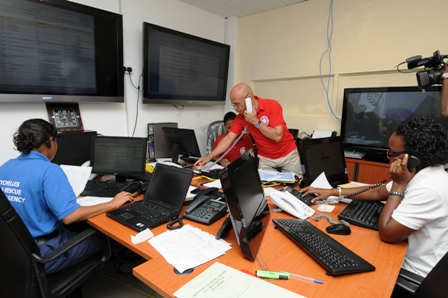Seychelles takes part in first test of tsunami warning system |13 October 2011

In all, more than twenty countries took part and the system, backed by the United Nations (U.N), tested effective emergency response and communication.
Evacuation drills were held in several companies and government agencies over the country with reports and notices sent by SMS, fax, email and telephone from the coordination centre based at the Divisions of Risk and Disaster Management (DRDM), Mont Fleuri.
Paul Labaleine, director general of Operations, Education and Communication for the DRDM, said the drill was supposed to start at 5am.
“The information is sent to us by the Regional Tsunami Service Provider (RTSP) which supplies information to the team after an earthquake which raises a potential tsunami threat hits the region,” said Mr Labaleine.
The drill, he added, involved prepared collaboration between countries and agencies such as India, Australia, the Japanese Meteorological Agency and the Pacific Tsunami Warning Centre, based in Hawaii.
“Normally, the first information in goes directly to the National Warning Centre at the Meteorological Office who analyses the information and if a tsunami threat exists, passes it on to us,” he said.
Mr Labaleine explained that after this step, their coordination centre is activated.
“Based on the magnitude and location of the earthquake, we can effectively prepare for any circumstances which may arise as well as issue a code red alert in which our first responders activate their emergency system or plan.”
Despite being on alert, Mr Labaleine explained that in the event of a drill, physical evacuation is not necessary.
“All the responders need to do in this case is acknowledge receipt of information, ensure their plans are in place and log the information provided.”
The expected time for the drill tsunami to hit in Seychelles was predicted to be around 11am.
“Despite having six hours before impact, we realised that there would still be issues with mobilising the authorities and services such as the police, the Island Development Company – for outer island evacuation, National Disaster Committee, Seychelles People’s Defence Forces, Land Transport, Ministry of Environment, Red Cross, District Administration, the Seychelles Tourism Board – to coordinate hotel evacuations, the fire services and the Coast Guard in case of rescues. Other services like shops would also be alerted so they may stock food in case of shortages later on.
“We also need to take into consideration the time it will take for our faxes, emails and SMS to deliver as well as the time it will take to get a response, what to do in cases of failed communication, evacuating offices in town, requesting assistance from the army and securing our critical facilities such as the Central Bank and other banks.”
During this time, Mr Labaleine said, all responders would need to report on their progress by the hour and let the coordination centre know if any problems were met.
“Overall, we’ve had very good response. So far, at least 75% of our first responders have been in touch with us and told us what they were doing and I’m satisfied with how the drill has turned out so far,” he said, when our reporter called him at around 11am to check on the progress of the drill.




